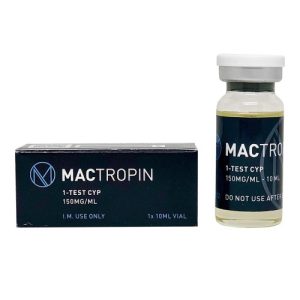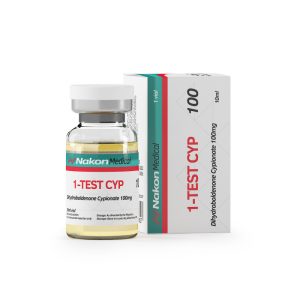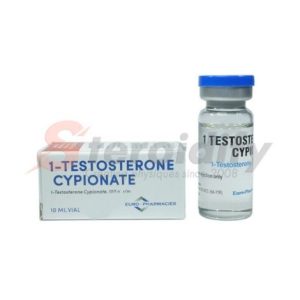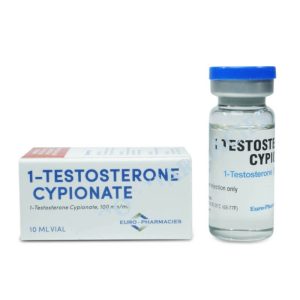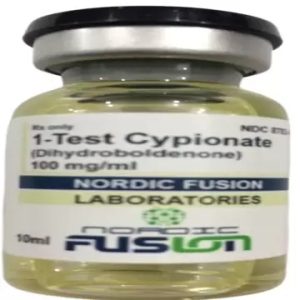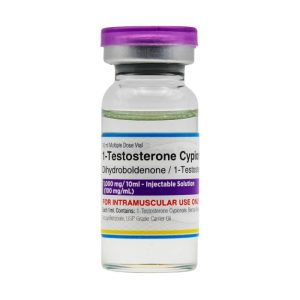Masteron is the brand name for the anabolic steroid Drostanolone. It is an injectable, oil-based anabolic steroid derived from dihydrotestosterone (DHT). The parent hormone makes Masteron a member of the family of anabolic steroids and analogues, i.e. derivatives of DHT. In essence, all varieties of anabolic steroids are, in one form or another, modifications of the three main hormones naturally present in the body: testosterone, dihydrotestosterone and nandrolone. The precursor or parent hormone of Masteron is dihydrotestosterone. Other substances belonging to the DHT family are : Anavar, Winstrol, Anadrol, Primobolan and others. Masteron is not listed as a strong anabolic steroid, but neither is it a weak anabolic steroid. Its anabolic potency is considered moderate (anabolic index 62-130), while its androgenic potency is rather low (25-40). It is therefore very different from testosterone, which is used as the benchmark for comparing anabolic steroid indices. Testosterone is the number-one hormone, the original natural steroid with an androgenic and anabolic index of 100.
Drug description and history
The formula for Masteron (under the brand name Drostanolone) was first introduced and published in 1959. Its origins are rather interesting. The substance was synthesized and produced by Syntex, a company known for developing other popular anabolic steroids such as Anadrol and Methyldrol (known as Superdrol). Just ten years after the formula was created, Masteron was finally brought to market. Lilly and Syntex collaborated to create and market several pharmaceutical products. The organizations agreed to jointly invest resources and bear the costs of research and development, while the rights to the drug would revert to one of the two companies, on a negotiated basis. In the end, the rights to Masteron were awarded to Lilly. The drug was introduced to the US market under the brand name Drolban. Syntex, instead of overseeing the distribution of Masteron on international markets, also sold this anabolic steroid.
Masteron was approved by the FDA (Food and Drug Administration) as a treatment for breast cancer patients. The drug was particularly suitable for women. Because Masteron has a lower androgenic index than testosterone, the incidence of virilization symptoms is lower than with other anabolic steroids. The drug’s prescriptions and instructions for use clearly indicate that the likelihood of developing virilization with Masteron is much lower than with similar doses of testosterone propionate. The problem, however, is that women were initially prescribed Masteron at a dose of 300 mg per week, which apparently proved too high. This is confirmed by the fact that in most cases, patients taking the drug at this dose experienced virilization. A similar problem was encountered by women taking Masteron long-term.
Chemical characteristics of Masteron
Masteron is the brand name for Drostanolone. As already mentioned, this drug is a modified form of DHT (dihydrotestosterone) and belongs to the family of DHT derivatives and analogues. Masterone’s methyl group is located on the second carbon atom (known as carbon-alpha). This modification is responsible for its anabolic power, which is significantly lower than that of testosterone. The addition of the methyl group enhances Masteron’s anabolic power by making it resistant to transformation into inactive metabolites by the enzyme 3-hydroxysteroid dehydrogenase. This enzyme, present in large quantities in muscle tissue, is responsible for metabolizing DHT into two inactive, non-anabolic metabolites: 3-alpha-androstenediol and 3-beta-androstenediol. For this reason, DHT in muscle tissue does not function as an anabolic agent. Many chemists and biologists agree that the absence of the enzyme 3-hydroxysteroid dehydrogenase in muscle would make DHT a very potent anabolic steroid.
However, the addition of Masteron’s methyl group to the 2-alpha carbon effectively compensates for its ability to be metabolized by the enzyme 3-hydroxysteroid dehydrogenase.
There are two varieties of Masteron: drostanolone propionate and drostanolone enanthate. The propionate variant is more popular than the enanthate. We explain why, using drostanolone propionate as an example. Propionate” is propanoic acid. When it interacts with Masteron, it creates a bond, known in chemistry as an ester bond. In the chemical structure of Drostanolone (Masteron), propanoic acid is linked to a 17-beta-hydroxyl group. The addition of this ester modifies the half-life and release period of the hormone, making it longer than the esterified hormone. The body’s enzymes break the bond between the ester and the hormone at different rates: the longer and larger the ester, the longer it takes to break the bond. As a result, the complex ester is expelled, leaving the pure Masteron (or any other pre-esterified anabolic steroid), which is now free to perform its function in the body. This characteristic of the enzymes that detach the ester from the testosterone molecule is responsible for the slow release and long half-life.
In the end, drostanolone propionate has a half-life of 2.5 days and drostanolone enanthate a half-life of 10 days. Etherification has no effect on the action and characteristics of the hormone, other than to increase its release rate and half-life.
Masterone properties
As a derivative of DHT, Masterone retains some of the characteristics of the parent hormone. In particular, it does not interact with aromatase. The enzyme aromatase is responsible for the conversion of androgens to estrogens, and Masterone is unaffected by this process. Consequently, whatever the dosage, Masteron has no estrogenic characteristics. This eliminates the risk of the drug’s side effects: water retention, increased blood pressure (as a result of water retention), potential fat gain/retention and gynecomastia. Those who use Masteron end up gaining muscle mass without water and without the effect of a soft, bloated body. This is why most bodybuilders and athletes prefer Masteron as an effective weight-loss product and as a drug for pre-competition drying courses.
Because of its moderate anabolic power, Masteron is not considered an effective way to gain mass and volume. Many experienced users of anabolic steroids believe that the high price and relatively low anabolic power make this drug useful only for bodybuilders, i.e. competitors who need a solid, precise appearance for a single performance on stage. It’s been confirmed that, in combination with other customized drugs, Masteron “tears” the body even more. But these “sealing” properties of Masteron are most noticeable in athletes with a low percentage of body fat. Otherwise, this effect is not perceptible. This brings us to the next and most important property of Masteron.
Masteron is a moderate aromatase inhibitor. It is also capable of blocking estrogen at receptors in breast tissue. This feature has made it a first-line treatment for breast cancer. On a lean body (with a fat percentage of 10 or less), Masteron has “firming” and “shaping” effects, as reported by many experienced users. Masteron works by inhibiting the enzyme aromatase, thereby eliminating the ability of estrogen to form from aromatized anabolic steroids during the aromatization process. Essentially, it reduces water retention as estrogen levels continue to fall due to the increase in inactive aromatase enzymes.
Side effects
The bodybuilding community considers Masteron to be one of the “easy” anabolic steroids. This also applies to its side effects. Derived from DHT, it has similar (or similar-like) attributes and functions. Its inability to interact with the aromatase enzyme completely eliminates estrogen-related side effects.
As already mentioned, Masterone, as a substance derived from DHT, is totally devoid of estrogen-related side effects. Not only is it not susceptible to aromatization (conversion to estrogen), but it has also been shown to behave as a mild aromatase inhibitor. Side effects resulting from estrogen accumulation, such as edema, fat retention and growth, and the development of gynecomastia, are completely eliminated or reduced with Masteron.
Showing 1–9 of 4898 results



